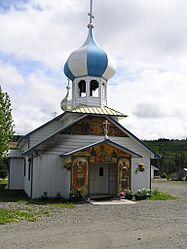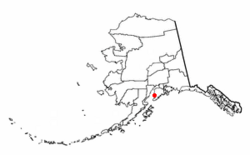Nikolaevsk, Alaska facts for kids
Quick facts for kids
Nikolaevsk, Alaska
|
|
|---|---|

Russian Old Believers Church in Nikolaevsk
|
|

Location of Nikolaevsk, Alaska
|
|
| Country | United States |
| State | Alaska |
| Borough | Kenai Peninsula |
| Area | |
| • Total | 34.84 sq mi (90.25 km2) |
| • Land | 34.84 sq mi (90.25 km2) |
| • Water | 0.00 sq mi (0.00 km2) |
| Elevation | 840 ft (256 m) |
| Population
(2020)
|
|
| • Total | 328 |
| • Density | 9.41/sq mi (3.63/km2) |
| Time zone | UTC-9 (Alaska (AKST)) |
| • Summer (DST) | UTC-8 (AKDT) |
| ZIP code |
99556
|
| Area code(s) | 907 |
| FIPS code | 02-54085 |
| GNIS feature ID | 1417063 |
Nikolaevsk (pronounced: nee-koh-LYE-evsk) is a small community in Alaska, a state in the United States. It is called a census-designated place (CDP). This means it's an area that the government counts for population, but it's not a formally organized city.
Nikolaevsk is located in the Kenai Peninsula Borough. In 2020, about 328 people lived there. This was a small increase from 318 people in 2010. The Nikolaevsk School serves all the kids in the area.
Contents
History of Nikolaevsk
Who Settled Nikolaevsk?
Nikolaevsk was started around 1968 by a group of people called Old Believers. They came from Oregon, but their families originally came from Russia. Even today, many people in Nikolaevsk are of Russian background.
Early Days and Churches
The story of how these Old Believers traveled from Russia and founded Nikolaevsk is quite interesting. It was featured in a 1972 article in National Geographic magazine. Later, in 2013, the NatGeo channel aired an episode called Russian Alaska. The Atlantic magazine also wrote about the community in 2013.
The first church in Nikolaevsk was built in 1983. A second church was built much later, in 2014.
Recent Community Changes
In May 2023, a big change happened for some Old Believers in Nikolaevsk. About 20 families, led by Father Nikola Yakunin and his son Deacon Vasily Yakunin, decided to join the Russian Orthodox Church Outside of Russia. This church is a part of the larger Moscow Patriarchate.
It was reported that many in the community had become more "Americanized." This meant it was hard for them to pray in Church Slavonic language, an old language that was almost forgotten by some. The community plans to build a new church in Homer, which is close to Nikolaevsk. The original church will stay with the Lipovan Orthodox Old-Rite Church.
Geography of Nikolaevsk
Where is Nikolaevsk Located?
Nikolaevsk is on the western side of the Kenai Peninsula in Alaska. It is next to the Anchor Point community to the south and west. To the north, it borders the Happy Valley community.
You can reach Nikolaevsk by road using North Fork Road. This road connects to the Sterling Highway about 9 miles (14 km) west in Anchor Point.
Land and Rivers
The community covers an area of about 34.8 square miles (90.2 square kilometers). All of this area is land, with no water. The North Fork of the Anchor River forms the southern edge of Nikolaevsk. The Chakok River makes up the western border.
Nikolaevsk is located in a type of forest called a boreal wet forest. This means it's a cool, moist forest area.
Climate in Nikolaevsk
Nikolaevsk has a subarctic climate. This means it has short, fairly mild summers and long, cold winters. The nearby ocean also affects the weather, making it a bit milder than other subarctic places.
The weather station "Homer 8 NW" is near Nikolaevsk. It is at an elevation of 1080 feet (329 meters).
| Climate data for Homer 8 NW, Alaska, 1991-2020 normals, 1977-2020 extremes: 1080ft (329m) | |||||||||||||
|---|---|---|---|---|---|---|---|---|---|---|---|---|---|
| Month | Jan | Feb | Mar | Apr | May | Jun | Jul | Aug | Sep | Oct | Nov | Dec | Year |
| Record high °F (°C) | 53 (12) |
52 (11) |
54 (12) |
67 (19) |
76 (24) |
79 (26) |
81 (27) |
82 (28) |
69 (21) |
59 (15) |
51 (11) |
46 (8) |
82 (28) |
| Mean maximum °F (°C) | 40.5 (4.7) |
41.7 (5.4) |
44.3 (6.8) |
51.8 (11.0) |
64.5 (18.1) |
69.3 (20.7) |
70.8 (21.6) |
69.1 (20.6) |
61.0 (16.1) |
52.4 (11.3) |
43.2 (6.2) |
40.0 (4.4) |
73.2 (22.9) |
| Mean daily maximum °F (°C) | 28.1 (−2.2) |
30.7 (−0.7) |
32.9 (0.5) |
41.8 (5.4) |
50.9 (10.5) |
57.2 (14.0) |
60.5 (15.8) |
59.6 (15.3) |
52.7 (11.5) |
41.9 (5.5) |
32.6 (0.3) |
29.1 (−1.6) |
43.2 (6.2) |
| Daily mean °F (°C) | 23.2 (−4.9) |
25.5 (−3.6) |
26.9 (−2.8) |
35.5 (1.9) |
43.6 (6.4) |
49.8 (9.9) |
53.8 (12.1) |
53.0 (11.7) |
46.7 (8.2) |
36.7 (2.6) |
27.7 (−2.4) |
24.5 (−4.2) |
37.2 (2.9) |
| Mean daily minimum °F (°C) | 18.3 (−7.6) |
20.4 (−6.4) |
20.8 (−6.2) |
29.2 (−1.6) |
36.4 (2.4) |
42.4 (5.8) |
47.0 (8.3) |
46.4 (8.0) |
40.7 (4.8) |
31.5 (−0.3) |
22.9 (−5.1) |
19.9 (−6.7) |
31.3 (−0.4) |
| Mean minimum °F (°C) | −1.2 (−18.4) |
3.4 (−15.9) |
4.9 (−15.1) |
17.1 (−8.3) |
28.5 (−1.9) |
35.5 (1.9) |
40.6 (4.8) |
39.1 (3.9) |
30.8 (−0.7) |
18.8 (−7.3) |
8.8 (−12.9) |
4.1 (−15.5) |
−4.9 (−20.5) |
| Record low °F (°C) | −30 (−34) |
−19 (−28) |
−6 (−21) |
−2 (−19) |
19 (−7) |
29 (−2) |
32 (0) |
31 (−1) |
19 (−7) |
2 (−17) |
−12 (−24) |
−17 (−27) |
−30 (−34) |
| Average precipitation inches (mm) | 2.08 (53) |
1.88 (48) |
1.24 (31) |
1.41 (36) |
1.24 (31) |
1.57 (40) |
2.33 (59) |
3.26 (83) |
4.56 (116) |
3.63 (92) |
3.19 (81) |
3.34 (85) |
29.73 (755) |
| Average snowfall inches (cm) | 17.60 (44.7) |
17.20 (43.7) |
13.30 (33.8) |
6.50 (16.5) |
0.60 (1.5) |
0.00 (0.00) |
0.00 (0.00) |
0.00 (0.00) |
0.60 (1.5) |
4.70 (11.9) |
13.70 (34.8) |
26.40 (67.1) |
100.6 (255.5) |
| Average precipitation days (≥ 0.01 in) | 12.8 | 11.6 | 10.1 | 10.3 | 11.8 | 12.5 | 14.1 | 16.3 | 18.0 | 16.3 | 13.6 | 16.0 | 163.4 |
| Average snowy days (≥ 0.1 in) | 10.1 | 9.4 | 8.9 | 4.2 | 0.8 | 0.0 | 0.0 | 0.0 | 0.3 | 2.9 | 7.9 | 12.3 | 56.8 |
| Source 1: NOAA | |||||||||||||
| Source 2: XMACIS2 (records & monthly max/mins) | |||||||||||||
People of Nikolaevsk
Population Changes Over Time
Nikolaevsk was first counted as a census-designated place (CDP) in the 1990 U.S. Census.
| Historical population | |||
|---|---|---|---|
| Census | Pop. | %± | |
| 1990 | 371 | — | |
| 2000 | 345 | −7.0% | |
| 2010 | 318 | −7.8% | |
| 2020 | 328 | 3.1% | |
| U.S. Decennial Census | |||
Ancestry and Languages Spoken
In 2000, most people in Nikolaevsk had Russian ancestry, making up about 67.5% of the population. Other ancestries included German (7.5%) and English (7.2%).
Many people in Nikolaevsk spoke Russian at home in 2000, about 66.57% of the population. The rest, about 33.43%, spoke English at home. A small number of people (5.52%) did not speak English well or at all.
Community Life
In 2000, there were 96 households in Nikolaevsk. More than half (57.3%) of these households had children under 18 living with them. Most households (65.6%) were married couples.
The average household had about 3.59 people. The average family had about 4.33 people. The community had a young population, with 45.2% of people under 18 years old. The average age was 21 years.
The median income for a household was $42,625. For families, it was $39,375. About 19.2% of the population lived below the poverty line. This included 20.9% of those under 18.
See also
 In Spanish: Nikolaevsk (Alaska) para niños
In Spanish: Nikolaevsk (Alaska) para niños

